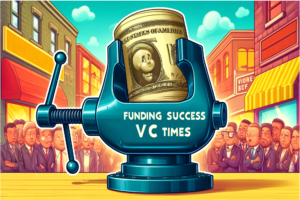Why capital-raising in 2025 demands wartime strategy—not peacetime storytelling.
Raising capital used to be a performance—slides, stories, and a splash of charisma. But 2025 isn’t buying that anymore. With global conflict looming, interest rates still elevated, and investors retreating into defensive postures, the capital landscape has changed and I would argue is harder than ever (Regardless of how many times you’re planning on saying “AI”).
This shift isn’t just affecting startups—it’s hitting seasoned operators, acquisitive CEOs, and family business leaders alike. Whether you’re raising to fund a roll-up, unlock liquidity, or seize a distressed asset, you’re no longer pitching a dream. You’re making a case for survival, scale, and return in a volatile world.
Today, capital isn’t curious—it’s cautious. Which means your approach has to evolve.
Capital Is at War—Your Story Should Be, Too
Across family offices, PE firms, and HNW circles, the investor mindset has turned tactical. They’re not looking for bold vision; they’re looking for clear advantages:
- Operational rigor > Storytelling finesse
- Cash flow control > Category potential
- Execution history > Optimism
- Downside protection > Upside hype
If your deck still opens with a market size chart and a founder bio, you’ve already lost the room.
Investors want clarity—fast. They want to know what you know that the market doesn’t. They want to see the asymmetry. And more importantly, they want to know how this asset performs under pressure.
You’re Not Selling Equity—You’re Transferring Conviction
Raising capital in this environment is not about persuasion. It’s about precision. The best operators aren’t “selling” at all—they’re transferring conviction through numbers, positioning, and preparedness.
Ask yourself:
- Can I articulate our competitive moat in 90 seconds?
- Do I demonstrate pricing power and margin control under stress?
- Have I mapped investor value before pitching my own?
This isn’t storytelling for attention—it’s briefing for alignment. Great capital partners aren’t interested in ideas. They’re interested in inevitabilities.
Pitch Less. Prove More.
What wins capital today is clarity, courage, and crisp control of the levers that matter. If your growth plan doesn’t highlight where you can pull forward cash flow or unlock strategic leverage in Q3—not 3 years from now—it’s noise.
Start treating capital conversations like Command Briefings:
- What’s the situation?
- What are the risks?
- Where’s the opportunity—and why you?
- How does their money win?
If you can’t answer those questions fluently, you’re not pitch-ready—you’re still rehearsing and have no business wasting the Capital Community’s time.
Closing Thought
In 2025, the winners aren’t the most innovative—they’re the most prepared. Capital will always find clarity. It’s your job to deliver it.
Whether you’re mid-deal, preparing to raise, or wondering why capital keeps ghosting you, this much is certain: The peacetime pitch is dead. The war room briefing is the new standard.
Sam Palazzolo
Real Strategies. Real Results.
P.S. – Want to pressure-test your capital readiness?
I built a 5-question diagnostic to cut through the noise:
Take the Catalyst Audit →
It’s free, fast, and built for operators who are done guessing.
KEY TAKEAWAYS
- Clarity is your currency | In 2025’s market, investors don’t want storytelling—they want situational awareness and precision. Your job is to deliver a fast, confident, data-backed briefing.
- You’re not pitching, you’re transferring conviction | Capital is earned when investors believe you understand the risks, the levers, and the outcomes better than they do.
- Operational discipline is the new charisma | Investors prioritize cash flow, pricing power, and margin control over big visions or energetic founders.
- Smart money is tactical, not curious | Family offices, PE, and HNW investors are scrutinizing geopolitical risk, inflationary pressure, and execution risk—your strategy must align.
- Your pitch is now a war room briefing | Capital allocators expect a clear, executive-level explanation of what the opportunity is, where the landmines are, and how their capital is shielded and scaled.
- Avoid persuasion theater—deliver investor logic | Focus on asymmetric upside, risk mitigation, and credible execution pathways—not just enthusiasm or slides.
- Great capital partners don’t fund noise | They fund inevitabilities. Your strategy must feel inevitable—and your leadership must prove it.




